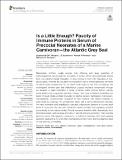Files in this item
Is a little enough? Paucity of immune proteins in serum of precocial neonates of a marine carnivoran—the Atlantic Grey Seal
Item metadata
| dc.contributor.author | McGill, Suzanne | |
| dc.contributor.author | Burchmore, Richard | |
| dc.contributor.author | Pomeroy, Patrick | |
| dc.contributor.author | Kennedy, Malcolm | |
| dc.date.accessioned | 2022-01-27T10:30:02Z | |
| dc.date.available | 2022-01-27T10:30:02Z | |
| dc.date.issued | 2022-01-27 | |
| dc.identifier | 276282021 | |
| dc.identifier | 9f1dba87-0850-4b5a-bc07-5395bd01ee52 | |
| dc.identifier | 000753705000001 | |
| dc.identifier | 85124553452 | |
| dc.identifier.citation | McGill , S , Burchmore , R , Pomeroy , P & Kennedy , M 2022 , ' Is a little enough? Paucity of immune proteins in serum of precocial neonates of a marine carnivoran—the Atlantic Grey Seal ' , Frontiers in Ecology and Evolution , vol. 9 , 802510 . https://doi.org/10.3389/fevo.2021.802510 | en |
| dc.identifier.issn | 2296-701X | |
| dc.identifier.other | ORCID: /0000-0003-1603-5630/work/107286954 | |
| dc.identifier.uri | https://hdl.handle.net/10023/24763 | |
| dc.description | The work was funded from core support given to the Sea Mammal Research Unit, Scottish Oceans Institute from the Natural Environmental Research Council (United Kingdom). | en |
| dc.description.abstract | Mammalian mothers usually provide their offspring with large quantities of immunoglobulins (antibodies) for circulation in blood, either trans-placentally before birth, via colostrum briefly thereafter, or, less commonly, from milk. Neonates of true, phocid seals, however, are peculiarly impoverished in serum immunoglobulins, the levels of which slowly increase but do not reach adult levels by the time of weaning. We investigated whether grey seal (Halichoerus grypus) neonates compensate through an elevation or rapid maturation in levels of serum innate immune factors, namely acute phase and complement proteins. Instead, their sera contained remarkably low levels of acute phase proteins (including C-reactive protein, haptoglobin, hemopexin, ceruloplasmin, orosomucoid), compared to their mothers, that barely increased to adult levels by weaning. For complement, there was a strong demarcation between the early activation and amplification cascade components (present at normal adult levels in pups) and the late lytic membrane attack complex and regulatory proteins (consistently at low relative levels). Phocid neonates therefore differ dramatically from land Carnivorans, such as dogs and cats, in early life immune protection. That neonatal phocids survive this apparent vulnerability to infections between birth and weaning prompts questions as to what other mechanisms protect them, and the adaptive value of their seeming vulnerability. | |
| dc.format.extent | 11 | |
| dc.format.extent | 1594853 | |
| dc.language.iso | eng | |
| dc.relation.ispartof | Frontiers in Ecology and Evolution | en |
| dc.subject | Atlantic grey seals | en |
| dc.subject | Halichoerus grypus | en |
| dc.subject | Immunoglobulins | en |
| dc.subject | Acute phase proteins | en |
| dc.subject | Complement factors | en |
| dc.subject | Innate immunity | en |
| dc.subject | QH301 Biology | en |
| dc.subject | QR180 Immunology | en |
| dc.subject | DAS | en |
| dc.subject | SDG 14 - Life Below Water | en |
| dc.subject.lcc | QH301 | en |
| dc.subject.lcc | QR180 | en |
| dc.title | Is a little enough? Paucity of immune proteins in serum of precocial neonates of a marine carnivoran—the Atlantic Grey Seal | en |
| dc.type | Journal article | en |
| dc.contributor.sponsor | NERC | en |
| dc.contributor.institution | University of St Andrews. Sea Mammal Research Unit | en |
| dc.contributor.institution | University of St Andrews. Marine Alliance for Science & Technology Scotland | en |
| dc.contributor.institution | University of St Andrews. Scottish Oceans Institute | en |
| dc.contributor.institution | University of St Andrews. Centre for Research into Ecological & Environmental Modelling | en |
| dc.contributor.institution | University of St Andrews. School of Biology | en |
| dc.identifier.doi | 10.3389/fevo.2021.802510 | |
| dc.description.status | Peer reviewed | en |
| dc.identifier.url | https://www.frontiersin.org/articles/10.3389/fevo.2021.802510/abstract | en |
| dc.identifier.grantnumber | Agreement R8-H12-86 | en |
This item appears in the following Collection(s)
Items in the St Andrews Research Repository are protected by copyright, with all rights reserved, unless otherwise indicated.

